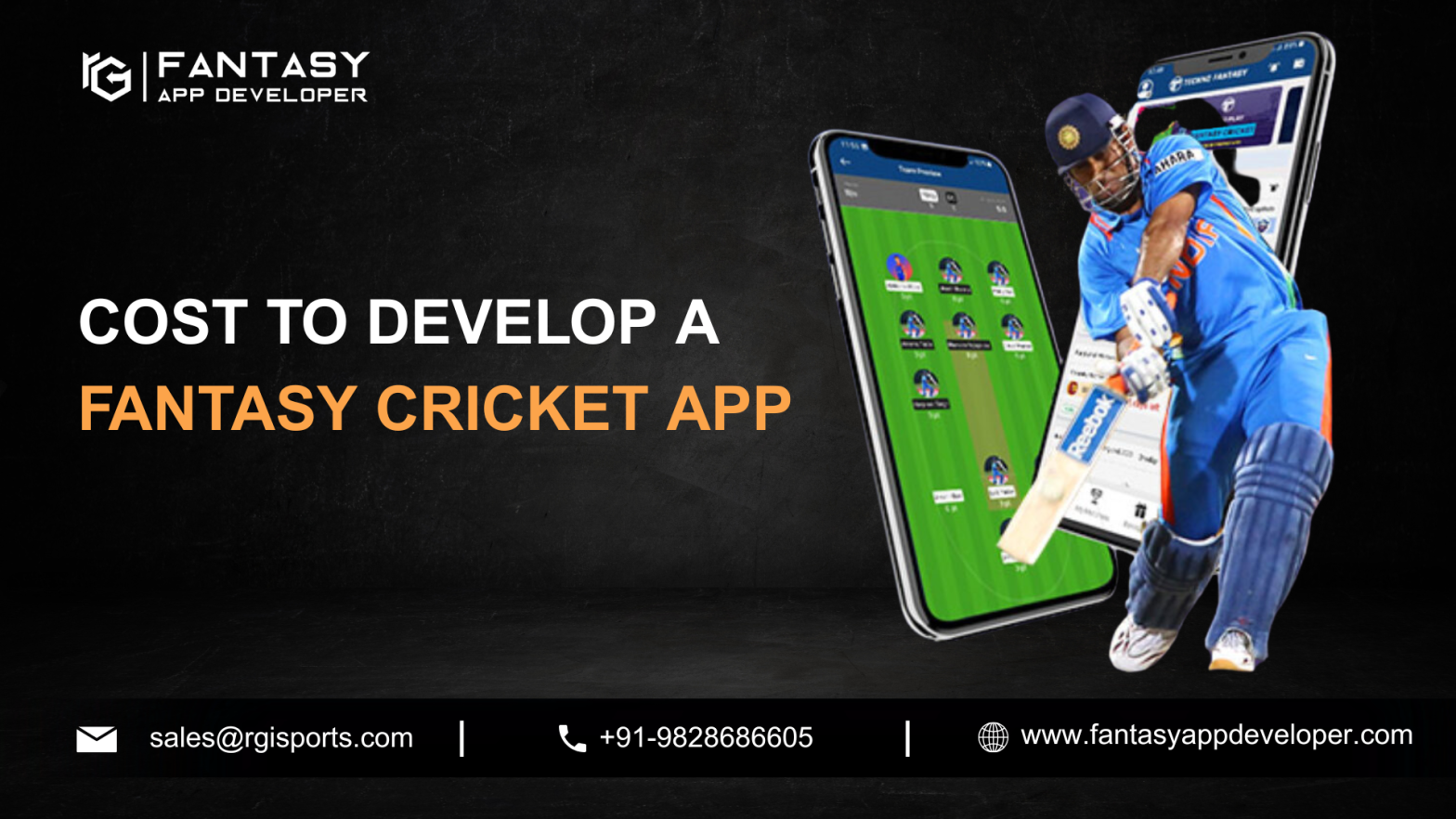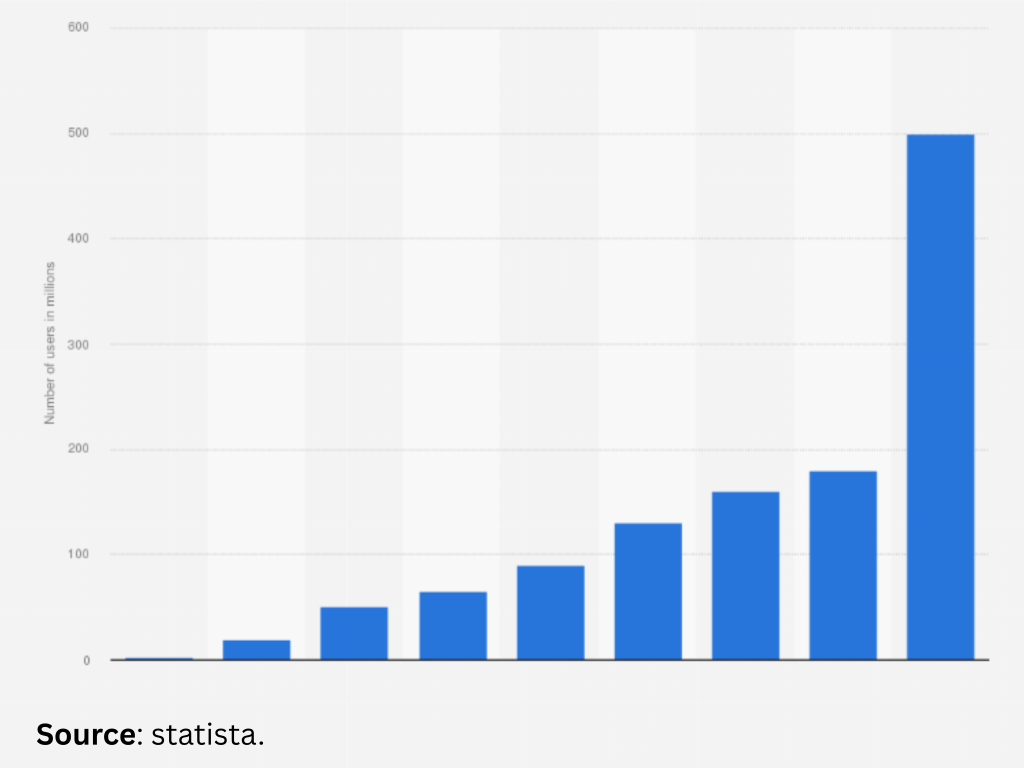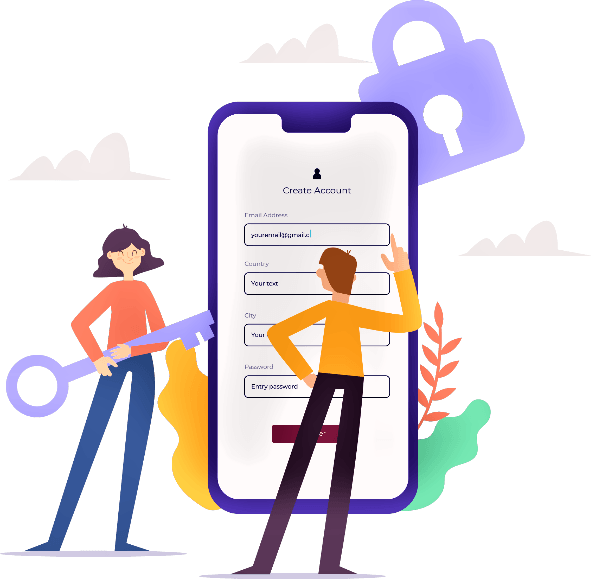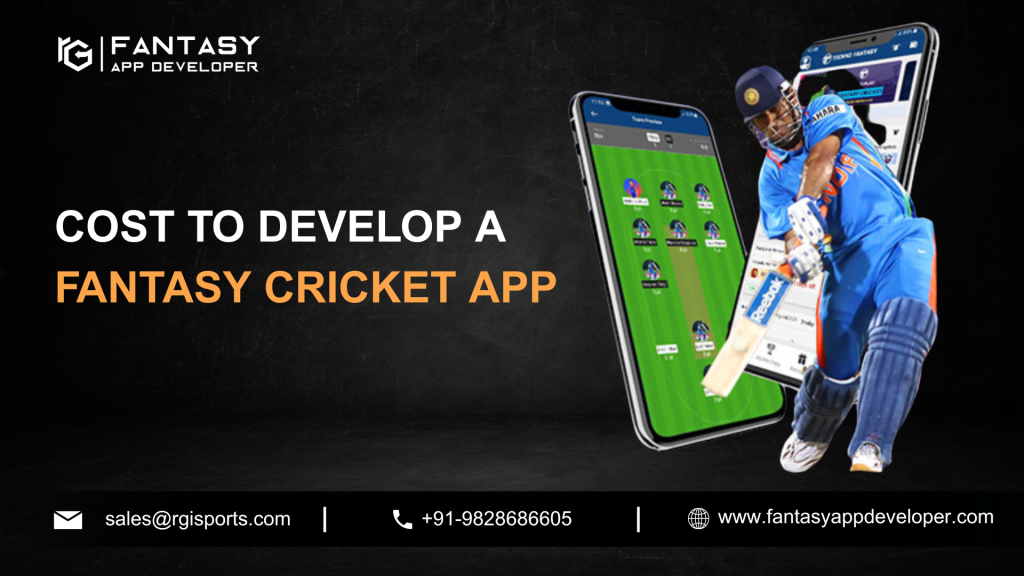
Summary:
Planning a fantasy cricket app development in 2025? Be prepared to spend ₹16 Lakhs to ₹35 Lakhs ($ 20,000-$45,000) based on the intricacy of features and the developer’s location. A successful launch will need budgeting not only for development but also for essential hidden expenses such as marketing, legal compliance, and sustained maintenance to secure long-term growth and success.
With millions of fans planning, the fantasy sports industry is a goldmine waiting to be tapped for entrepreneurs. But before you rise to the crease and launch your platform, the fundamental question remains to define: What does it cost to create a fantasy cricket app in 2025?
This blog is your one-stop guide to grasping each financial detail of developing a fantasy cricket app. We will deconstruct the expenses, delve into the variables that affect the end budget, and give you a pragmatic cost map.
You could either be a startup founder or an existing business with expansion aspirations. In this in-depth analysis, we’ll provide you with the right information so that you can make well-informed decisions.
Why You Need to Create a Fantasy Cricket App
India’s fantasy sports industry is not only expanding; it’s booming. The market is expected to touch a whopping $6.12 billion by 2027, with over 130 million users. This colossal growth is driven by rising smartphone adoption, low-cost data plans, and high-profile cricket events such as the IPL.
As per the reports by Statista, the number of fantasy sports users registered in India increased to around 180 million by the financial year 2023. In keeping with the growth trend that started going upward in 2017, this base of users was projected to cascade to half a billion in fiscal year 2027. We hope that the reports provided will create interest in you to develop your app. In case you have more questions, read the How to create a sports betting app blog to comprehend clearly.
Rolling out a fantasy cricket app at this time is about riding on a highly active and fast-growing base, presenting a huge opportunity for revenue and brand development.
Key Factors That Influence Fantasy Cricket App Development Costs
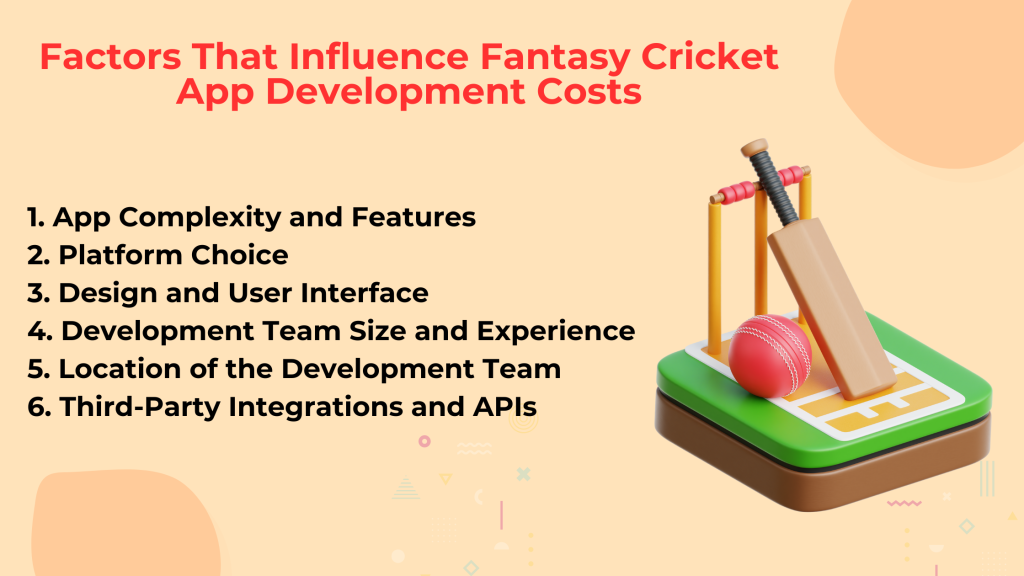
The total cost of bringing your fantasy cricket app to life is not a single figure but a sum of several critical variables. Understanding these factors is the first step toward creating a realistic budget and a successful product.
1. App Complexity and Features
This is the biggest cost driver. The more features you add and the more complicated their underlying logic, the higher the number of development hours.
| Platform | Development Type | Estimated Cost Impact |
|---|---|---|
| iOS + Android (Native) | Separate Swift & Kotlin apps | 1.6x – 1.8x base cost (e.g. $90k – $150k) |
| Cross-Platform | Flutter / React Native | Reduces cost by 30% – 40% (e.g. $60k – $80k) |
Minimum Viable Product (MVP) – A simple version of the app intended to hit the ground running as soon as possible and see how the market responds.
- Features: User login/register, basic profile, look at future matches, make one team per match, participate in public contests, and see a basic leaderboard.
- Why it’s more affordable: The reasoning is simple, and the feature set is minimal, minimizing development and testing time.
- Feature-Rich Application: With A Higher Price Tag Comprehensive platform competing with the existing market players.
- Advanced Features: Personal contests, one-on-one challenges, live chat feature inside contests, multiple team entry, referral reward schemes, artificially intelligent player recommendation, real-time performance statistics of players, and comprehensive user analytics.
- Why it’s more expensive: Complex algorithms are needed for calculating points in real-time for thousands of users, managing multiple contest types, and ensuring the platform is scalable and secure. Each additional feature adds layers of development, integration, and testing.
2. Platform Choice (iOS, Android, or Cross-Platform)
Your choice of platform dictates your reach and your budget.
| Platform | Development Type | Estimated Cost Impact |
|---|---|---|
| iOS + Android (Native) | Separate Swift & Kotlin apps | 1.6x – 1.8x base cost (e.g. $90k – $150k) |
| Cross-Platform | Flutter / React Native | Reduces cost by 30% – 40% (e.g. $60k – $80k) |
Native App Development (iOS & Android separately):
Building two separate applications from the ground up—one for Apple’s iOS (using Swift) and another for Google’s Android (using Kotlin).
Cost Impact: This is the most costly option, approximately 1.6x to 1.8x the price of a single cross-platform application. It provides the greatest performance and strongest integration with device capabilities, but typically constitutes overkill for the majority of fantasy applications.
Cross-Platform App Development:
Writing with a single framework, such as Flutter or React Native, to produce a single codebase that can run on both iOS and Android.
Cost Impact: This is the new, cost-saving standard for startups and enterprises. It cuts development time and expense by 30-40% in comparison to native development, enabling a speedy launch without sacrificing substantially on user experience.
3. Design and User Interface (UI/UX) Requirements
First things first in the app world. Your design quality goes straight to user interaction and retention.
| Design Approach | Inclusions | Estimated Cost (USD) |
|---|---|---|
| Template-Based Design | Pre-designed UI, generic layouts | $3,000 – $6,000 |
| Custom UI/UX Design | Wireframes, unique visuals, user research, branding | $5,000 – $15,000 (10–15% of total cost) |
Basic/Template-Based Design (Lower Cost): Leveraging pre-designed design templates and generic UI components. It’s quick to deploy and functional, but might not offer a distinct brand identity.
Custom UI/UX Design (Higher Cost): This entails an exclusive process of research, wireframing, interactive prototype creation, and designing a one-of-a-kind, attractive, and intuitive interface from the ground up. Though more costly—generally 10-15% of the overall project cost—a custom UI/UX is a strong differentiator that can result in greater user satisfaction and app success.
4. Development Team Size and Experience
The composition and expertise of your team are directly tied to your budget.
| Team Type | Roles | Hourly Rate | Total Project Cost Impact |
|---|---|---|---|
| Junior Team (Less Exp.) | Entry-level developers, basic QA | $20 – $40/hr | Lower cost, longer timeline |
| Mid-Senior Level Team | 5+ yrs exp, PM, QA, 2–3 devs, designer | $40 – $100/hr | Faster, better code quality |
| Estimated Total | Full team for 3–6 months | $30,000 – $80,000+ | Depends on complexity |
Team Structure: A typical team for a mid-complexity app includes:
- 1 Project Manager
- 1 UI/UX Designer
- 2-3 Developers (Frontend & Backend)
- 1 Quality Assurance (QA) Tester
Experience: An experienced team of developers with 5+ years of experience will command higher hourly rates than a junior developer team. But efficiency, ability to solve complex problems, and writing clean, scalable code often result in faster delivery and a more stable final product, offering greater long-term value.
5. Location of the Development Team
This is one of the most significant variables affecting the overall cost. The hourly rate for a developer varies dramatically worldwide.
| Region | Hourly Rate (USD) | Total Project Cost Impact |
|---|---|---|
| North America (US/CA) | $100 – $250/hr | $150,000 – $250,000 |
| Western Europe (UK/DE) | $80 – $200/hr | $120,000 – $200,000 |
| Eastern Europe (PL/UA) | $40 – $100/hr | $60,000 – $100,000 |
| India | $20 – $50/hr | $30,000 – $70,000 |
High-Cost Regions:
North America (USA/Canada): $100 – $250 per hour
Western Europe (UK/Germany): $80 – $200 per hour
Mid-Cost Region:
Eastern Europe (Poland/Ukraine): $40 – $100 per hour
Cost-Effective Areas (High Value):
India: $20 – $50 per hour
A company can reduce the development costs by 50-70% by outsourcing its development to a skilled agency in India, compared to hiring a team in the US without compromising on the quality or technical expertise.
6. Third-Party Integrations and APIs
Your fantasy cricket app cannot function in isolation. It relies on external services to provide core functionalities.
| Integration Type | Examples | Estimated Cost |
|---|---|---|
| Sports Data APIs | Sportradar, Dream11 API, etc. | $3,000 – $10,000/year |
| Payment Gateways | Razorpay, Stripe, Paytm | $1,000 – $2,000 (one-time) + per txn fee |
| Notifications (Push) | Firebase, OneSignal | $300 – $1,000 |
| SMS/OTP Verification | Twilio, MSG91 | $500 – $2,000/year |
| Analytics Tools | Google Analytics, Mixpanel | $300 – $1,000/year |
Sports Data APIs (Recurring Cost): This is essential for live match scores, player statistics, and match schedules. Services like Sportradar or Stats Perform provide this data but charge significant annual licensing fees, which must be included in your operational budget.
Payment Gateways: To handle user deposits and withdrawals, you need to integrate secure payment gateways like Razorpay, Paytm, or Stripe. This involves a one-time development effort and a per-transaction fee charged by the provider.
Other Integrations: This can include services for push notifications (e.g., Firebase Cloud Messaging), SMS verification (e.g., Twilio), and analytics (e.g., Google Analytics), each potentially adding to the development and operational cost.
| Factor | Impact on Cost | Description |
|---|---|---|
| App Complexity & Features | High | A basic app with minimal features will be much less expensive than a complex app with AI-powered analytics, real-time chat, and AR/VR support. |
| Platform Selection | Medium | It's more expensive to create an app for one platform (iOS or Android). A cross-platform solution with frameworks such as React Native or Flutter might be cheaper than creating two native apps. |
| Design & User Interface (UI/UX) | Medium | A custom-built, intricately animated UI/UX will be more costly than a design based on templates. Nonetheless, a wonderful user experience is key to retention. |
| Development Team | High | The size, skill level, and location of your development team are significant drivers of cost. A senior-level, large team based in North America will be more expensive than a mid-sized team in a place like India. |
| Third-Party Integrations | Medium | Third-party API integration to live scores, player statistics, and payment gateways contributes to the cost, both in terms of development time and possibly subscription charges. |
Core Features and How They Affect Costs
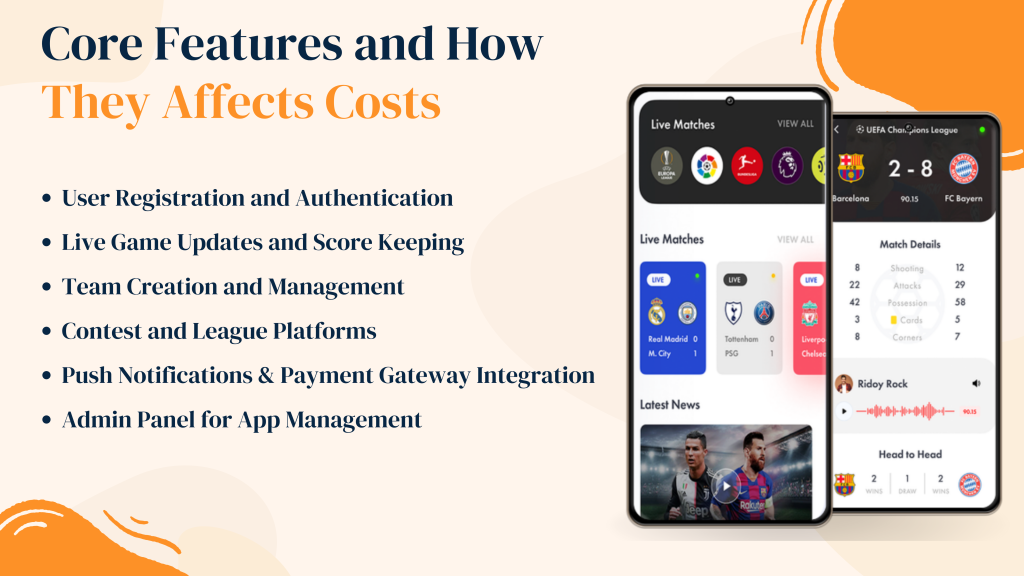
Features of your app comprise the blocks upon which its cost is based. Here are some must-have features for a fantasy sports app, and what they will cost.
| Feature | Estimated Cost (USD) | Cost Impact |
|---|---|---|
| User Registration & Authentication | $2,000 – $4,000 | Medium |
| Live Game Updates & Scorekeeping | $2,000 – $4,000 (dev) + $3,000 – $10,000/year (API) | High (initial + recurring) |
| Team Creation & Management | $3,000 – $6,000 | High |
| Contest & League Platforms | $3,000 – $6,000 | High |
| Payment Gateway Integration | $1,500 – $3,000 (one-time) + per-transaction fees | Medium |
| Push Notifications | $500 – $1,500 | Low |
| Admin Panel for App Management | $5,000 – $10,000 | High (20–30% of backend) |
User Registration and Authentication
User Registration and Authentication are must-have features. However, what it costs may vary. The standard is usually an email/password login. Another complexity and cost associated with social media integration, such as Google or Facebook, and one-time password verification.
Live Game Updates and Score Keeping
This is not negotiable. It demands integration with a high-quality sports API provider (such as Sportradar or Stats Perform). The price involves both the integration time and the monthly recurring cost of the API, which can be very expensive.
Team Creation and Management
The core of the user experience. This involves complex logic for player selection, credit limits, and captain and vice-captain choices. The smoother and more intuitive this process is, the more development hours it will require.
Contest and League Platforms
From free-to-play competitions to high-stakes leagues, this module is your main profit driver. Evolving the logic for various contest types (Head-to-Head, Mega Contests, Private Leagues) is a major cost center.
Push Notifications & Payment Gateway Integration
A must for user interaction, reminding people of match kick-offs, lineup updates, and winnings. Not the most costly feature, but requires gentle handling to prevent spammyness. Securely handling deposits and withdrawals is critical for user trust. Integrating well-known gateways like Razorpay, Stripe, or PayPal involves development costs and transaction fees.
Admin Panel for App Management
This will be the core of your operations, where you can handle users, contests, payments, and content. An efficient and user-friendly admin panel is an essential investment, usually worth 20-30% of backend development.
Advanced Features and Additional Costs

To differentiate yourself in a competitive market, you may want to look at advanced features. These will have a major impact on your budget, but can give you a good competitive edge.
Real-time Chat or Community Features: Creating a community where users can talk about matches and strategies can drive engagement and retention.
AI-Powered Player Performance Analysis: Providing users with AI-driven player selection recommendations based on previous performance, pitch conditions, and strength of opponents is a value-added, high-cost premium feature.
Multi-language Support: Supporting a multilingual, multicultural user base in India can increase your user base, but it is very costly in terms of translation and localization.
Custom Animations and Gamification: Features such as leaderboards, badges, and referral rewards can increase the application’s interest, but contribute to the design and development schedule.
| Advanced Feature | Estimated Cost (USD) | Cost Impact |
|---|---|---|
| Real-time Chat / Community Features | $2,000 – $5,000 | Medium to High |
| AI-Powered Player Performance Analysis | $4,000 – $8,000 | High |
| Multi-language Support | $3,000 – $6,000 | Medium |
| Custom Animations & Gamification | $2,000 – $4,000 | Medium |
A Detailed Breakdown of Development Cost In 2025
It takes a multi-step approach to develop a solid fantasy cricket app. Here, we analyze each step in detail, describing its purpose and its rough percentage of the overall project cost.
| Phase | Description | % of Total Cost | Estimated Cost (USD) |
|---|---|---|---|
| 1. UI/UX Design | Wireframes, prototypes, custom UI, competitor research | 10% – 15% | $5,000 – $10,000 |
| 2. Frontend Development | User interface coding, animations, responsiveness (Flutter/React Native) | 20% – 25% | $10,000 – $20,000 |
| 3. Backend Development | Business logic, server setup, user handling, contests, API endpoints | 25% – 30% | $12,000 – $25,000 |
| 4. API Integration | Payment gateways, sports data APIs (dev only, not licensed) | 10% | $4,000 – $8,000 |
| 5. Testing & QA | Manual, automated, load, and security testing | 10% – 12% | $4,000 – $10,000 |
| 6. Post-Launch Support & Updates | Bug fixes, OS upgrades, maintenance (annual, post-launch) | 15% – 20% (yearly) | $5,000 – $10,000/year |
1. UI/UX Design (User Interface & User Experience)
This is your app’s architectural and aesthetic roadmap. It’s not only about making your app look nice; it’s about making it easy, intuitive, and fun to use for your users. A good UI/UX is imperative for user retention.
Competitor analysis, market research, wireframing (skeletal form), creating a final polished visual interface (UI), creating interactive prototypes, and developing user personas.
An original, visually-engaging design with special animations will be more expensive than a basic, template-form design. For a fantasy app, where users are spending a lot of time, the investment in a good UX is not optional.
2. Frontend Development (Client-Side)
This is where the UI/UX design comes into being. Frontend coders develop the code for all that the user can see and use on their screen, be it buttons and menus, the team creation screen, or the leaderboards.
Coding the visual components, introducing animations and transitions, making the app responsive to various screen sizes, and linking the user interface with the backend server using APIs.
It forms a critical chunk of the budget. Cross-platform frameworks such as Flutter or React Native are the norm, a cost-efficient way of going about it here.
3. Backend Development (Server-Side)
The backend is the heartbeat of your app. It is the server-side logic that takes care of all the important things that the user never gets to see, like user data management, crafting points calculations, executing contests, and making payments. A robust, scalable backend is necessary to serve thousands of users at a time, particularly during live matches.
Creating the core application logic, initializing databases (such as MongoDB or MySQL), developing the admin interface, and designing the APIs that the frontend will interact with.
It is usually the biggest individual item in the development cost because of its complexity and criticality to performance and scalability.
4. API Integration
Your application must integrate with third-party services to operate. This involves integrating a live cricket score data feed and a payment gateway for transactions.
Integrating third-party APIs for live cricket scores (i.e., Sportradar, CricAPI), player stats, and payment gateways (i.e., Razorpay, Stripe).
This incorporates the integration hours of development for the integration itself. Observe that the licensing costs of these APIs are an additional, ongoing operational expense; these are not included in the initial development cost.
5. Testing and Quality Assurance (QA)
This is an important stage to make sure your app is stable, free of bugs, and runs smoothly under heavy load. A separate QA team aggressively tests each feature on various devices and operating systems.
Manual testing (user-focused exploration of the app), automated testing (scripted repetitive checks), performance testing (testing for speed and stability under heavy load), and security testing.
Skipping or short-cutting this step is a false economy. An app with bugs will lose users and trust very rapidly.
6. Post-Launch Support and Maintenance
The app launch is only the start. Regular maintenance is needed to ensure it continues to operate flawlessly.
Resolving bugs that arise after the app goes live, routine server maintenance, updating the app for support of new OS versions (such as new iOS or Android versions), and providing technical support.
This is an annual operational expense, not an initial fee. An average industry benchmark is 15-20% of the original development cost, annually.
Technology Stack and Its Influence on Costs
The technologies used to build your app are its digital DNA. Your choice will have a lasting impact on cost, performance, and scalability.
| Category | Technology Options | Purpose | Cost Impact |
|---|---|---|---|
| Frontend (App Layer) | - Flutter - React Native | Cross-platform mobile development | $20,000 – $40,000 (base dev) |
| - Swift (iOS) - Kotlin (Android) | Native development (for max performance) | $35,000 – $60,000 (combined) | |
| Backend | - Node.js - Python (Django/FastAPI) | Server logic, API management, real-time data handling | $8,000 – $20,000 |
| Database | - MongoDB (NoSQL) - Firebase | Dynamic user data, real-time updates | $1,500 – $3,500 setup + usage |
| Cloud Hosting | - AWS - Google Cloud (GCP) | App hosting, scalability, and file storage | $100 – $1,000/month |
| CDN & Media Storage | - AWS S3 - Cloudflare CDN | To serve media assets (profile pics, etc.) quickly | $100 – $300/month |
| Authentication | - Firebase Auth - Auth0 | Secure user login, OTP, and social login integration | $500 – $1,500 setup + usage |
Popular Frameworks: React Native and Flutter are the leading cross-platform frameworks. They reduce development time and cost by allowing for a single codebase for both iOS and Android. Native development (Swift for iOS, Kotlin for Android) offers the best performance but at a higher price tag.
Backend Technologies: Node.js and Python are two strong contenders for creating scalable and robust backends that can support real-time data and even millions of concurrent users.
Database Choices: MongoDB (NoSQL) and Firebase (Realtime Database) work great in coping with the dynamic and high-volume data needs of a fantasy app.
Server and Cloud Hosting Fees: Solutions such as Amazon Web Services (AWS) or Google Cloud Platform (GCP) offer a scalable server platform on which your app can operate. Prices are based on usage and will scale with your growing user base.
Hiring Options and Cost Fluctuations
Your choice of a development partner has the biggest impact on the final cost.
| Hiring Model | Advantages | Disadvantages | Cost Impact |
|---|---|---|---|
| Freelancers | Lower cost, flexible. | Management overhead, potential for inconsistency. | Low-Medium |
| In-house Team | Full control, deep integration. | High cost (salaries, benefits), recruitment challenges. | High |
| Outsourcing Agency | Access to a full team (PM, Devs, QA), structured process, and cost-effective (especially in regions like India). | Less direct control, communication can be a challenge. | Medium-High (but often best value) |
Cost Optimization Techniques For Developing a Fantasy Cricket App
Want to create a fantastic app on a shoestring budget? Here are some tips:
- Begin with an MVP (Minimum Viable Product): Roll out with only the bare minimum features. This lets you get into the market quickly, collect user feedback, and subsequently add more features in an iterative manner based on demand.
- Cross-Platform Development: Utilize frameworks such as Flutter or React Native to create for iOS and Android at the same time, reducing development costs by up to 40%.
- Use Open-Source Technologies: Selecting open-source technologies for your database and backend will cut down licensing costs.
- Phased Development: Rather than constructing everything simultaneously, develop in phases. This stretches out the cost over time and permits one to fine-tune the strategy on the basis of the response received from the market.
Hidden Expenses of Fantasy Cricket App Development
Though the initial build is the most apparent cost, an astute entrepreneur plans for the lifespan of the app. Ignoring the costs below can bring a promising start to an unviable business.
1. App Store Fees and Compliance
You can’t have an app without somewhere to put it, and the big app stores are landlords of cyberspace.
Developer Account Charges:
- Apple App Store: An annual recurring charge of $99 (around ₹8,200) is needed to keep your developer account active and your app listed.
- Google Play Store: A less stringent one-time charge of $25 (about ₹2,100) is levied for account registration.
2. User acquisition and marketing expenses
Creating the best app for nothing if nobody can find out that it is there. Marketing is not a luxury; it is a growth-critical investment.
- Why It’s a Big Expense: The fantasy sports space, particularly here in India, is highly competitive. You’re going to be competing with the likes of Dream11 for user attention.
- Cost Per Install (CPI): The average you’ll pay per user you get to install your app. In India, for 2025, you should anticipate:
- Average CPI: ₹70 – ₹250 ($0.85 – $ 3.00) per install, varying based on ad platform and targeting.
- Budget for a Launch: A realistic minimum launch marketing budget to achieve initial traction should be ₹4,00,000 to ₹12,00,000 ($5,000 – $15,000). This budget would include:
- Digital Ads: Google Ads, Meta (Facebook/Instagram), and X (formerly Twitter) campaigns.
- Influencer Marketing: Collaborating with cricket experts and social media influencers on YouTube and Instagram to market your app.
- App Store Optimization (ASO): Making sure your app is discoverable in the App Store and Play Store.
3. Legal and Licensing Fees
This is perhaps the most important unseen expense to sort out. Bending the law is unavoidable.
Game of Skill vs. Game of Chance:
Fantasy cricket is legal in the majority of Indian states since it has been deemed a “game of skill” by the Supreme Court. But you require a legal team to design your contest rules and platform mechanics so that they fit within this definition.
Mandatory Legal Work & Fees:
- Legal Advice: Preliminary consultation with a law firm that has expertise in gaming law and IT law can range from ₹50,000 to ₹1,50,000 ($600 – $1,800).
- Policymaking: Writing a strong Privacy Policy, Terms of Service, and Fair Play Policy is critical. This will take another ₹40,000 to ₹1,00,000 ($500 – $1,200).
- Company Registration: Incorporating a Private Limited Company or LLP for carrying on the business.
- GST and TDS Compliance: Your platform has to be designed to manage GST on platform charges and TDS on winnings above ₹10,000.
Not investing in legal compliance from the very beginning may result in heavy fines or your company being closed down. To learn about laws, check our guide and understand the legal compliances on fantasy sports in detail.
4. Periodic Updates & Bug Fixes
Periodic Updates: Apple and Google issue major updates to iOS and Android annually. Your app will need to be updated to keep up, or else it will suddenly stop working for users who upgrade their phones.
Bug Fixes: There is no such thing as a bug-free app. As more and more users sign up, new bugs will be found that must be fixed quickly to avoid a subpar user experience.
Security Patches: Hackers are always discovering new vulnerabilities. Having regular security patches is important in order to secure your platform and your users’ information and money.
Performance Optimization: Keeping the app fast and responsive as your user base increases and new features are added.
These covert expenses are part of your business plan. With their anticipation and budgeting, you place your fantasy cricket app on the path of stability, growth, and ultimate success in the market.
Most Popular Fantasy Cricket Clone Apps & Price
It’s not possible to quote the precise price of apps such as Dream11, since they are products of years of ongoing development and multi-million dollar investments. But we can estimate how much it could cost to develop an app with a comparable core feature set today.
1. Dream11-like App:
Key Features: Support for various sports, large assortment of types of contests (Mega, Head-to-Head, Private), sophisticated UI, expert insights, high scalability for millions of users, strong security.
Estimated Cost to Clone Core Features: $60,000 – $100,000+
Cost Breakdown:
- Backend & Admin Panel: $30,000 – $45,000 (To support massive scale)
- Frontend (Cross-Platform): $20,000 – $30,000
- UI/UX & Features: $10,000 – $25,000
2. Vision11-like App (or other mid-tier apps):
Key Features: Mostly cricket-centric, more straightforward contest designs, typical UI, decent performance for a big user base, but not at Dream11’s level.
Estimated Cost to Replicate Core Features: $30,000 – $50,000
Cost Breakdown:
- Backend & Admin Panel: $15,000 – $20,000
- Frontend (Cross-Platform): $10,000 – $15,000
UI/UX & Features: $5,000 – $15,000
Why Should You Partner With a Fantasy App Developer for Cricket Clone App Development?
It is of the utmost importance that the right development partner be selected. An Indian-based company, such as Fantasy App Developer, provides a strategic edge. They have more than a decade of experience in fantasy sports apps, as shown in their portfolio, so they come with proven credentials. Having a firm such as Fantasy App Developer as a development partner offers:
- Cost-Effectiveness: Take advantage of the lower hourly development rates in India without sacrificing quality.
- Dedicated Team: Have access to a complete stack team of experienced developers, designers, and testers who are familiar with the subtleties of fantasy sports app development.
- End-to-End Service: From conceptualization and UI/UX design to development, testing, and post-launch maintenance, they take care of the complete project cycle.
- Proven Track Record: Their body of work illustrates their ability to develop scalable, secure, and interactive mobile applications.
Conclusion
Creating a fantasy cricket app in 2025 is an exciting opportunity, but it requires prudent financial management. The ultimate price is a canvas interwoven with your idea, feature selection, and development approach.
By beginning with a focused MVP, using an apt technology stack, and opting for a development partner that provides expertise along with value, you can make your love for cricket a successful digital enterprise. Spend wisely, plan thoroughly, and you’ll be more than halfway to scoring a six in the cutthroat fantasy sports environment.
Frequently Asked Questions
These two are the largest determinants of complexity and location of the development team. A feature-laden app developed in North America will be several times more expensive than a plain MVP app developed in India.
A straightforward MVP will take 3-4 months, a medium-level app will take 4-6 months, and a high-end, intricate app will take 6-9 months or longer.
It is extremely difficult to create a solid and scalable fantasy application under $10,000. This amount of money may only pay for a very simple prototype with extensive tradeoffs in quality, security, and scalability.
The main revenue model is commission or platform fee on the entrance fees of paid contests. The other models are advertising, paid subscription for extra analysis, and sponsorship from brands.
For the majority of use cases, such as fantasy cricket, new cross-platform toolkits like Flutter and React Native offer an app-like experience with a substantial decrease in cost and time-to-market. Native is generally saved for apps needing to deliver extreme graphical performance or deep, unique OS-level integrations.
